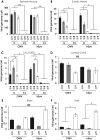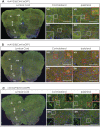Gene Transfer in Rodent Nervous Tissue Following Hindlimb Intramuscular Delivery of Recombinant Adeno-Associated Virus Serotypes AAV2/6, AAV2/8, and AAV2/9
- PMID: 32363345
- PMCID: PMC7176396
- DOI: 10.1177/1179069519889022
Gene Transfer in Rodent Nervous Tissue Following Hindlimb Intramuscular Delivery of Recombinant Adeno-Associated Virus Serotypes AAV2/6, AAV2/8, and AAV2/9
Abstract
Recombinant adeno-associated virus (rAAV) vectors have emerged as the safe vehicles of choice for long-term gene transfer in mammalian nervous system. Recombinant adeno-associated virus-mediated localized gene transfer in adult nervous system following direct inoculation, that is, intracerebral or intrathecal, is well documented. However, recombinant adeno-associated virus delivery in defined neuronal populations in adult animals using less-invasive methods as well as avoiding ectopic gene expression following systemic inoculation remain challenging. Harnessing the capability of some recombinant adeno-associated virus serotypes for retrograde transduction may potentially address such limitations (Note: The term retrograde transduction in this manuscript refers to the uptake of injected recombinant adeno-associated virus particles at nerve terminals, retrograde transport, and subsequent transduction of nerve cell soma). In some studies, recombinant adeno-associated virus serotypes 2/6, 2/8, and 2/9 have been shown to exhibit transduction of connected neuroanatomical tracts in adult animals following lower limb intramuscular recombinant adeno-associated virus delivery in a pattern suggestive of retrograde transduction. However, an extensive side-by-side comparison of these serotypes following intramuscular delivery regarding tissue viral load, and the effect of promoter on transgene expression, has not been performed. Hence, we delivered recombinant adeno-associated virus serotypes 2/6, 2/8, or 2/9 encoding enhanced green fluorescent protein (eGFP), under the control of either cytomegalovirus (CMV) or human synapsin (hSyn) promoter, via a single unilateral hindlimb intramuscular injection in the bicep femoris of adult C57BL/6J mice. Four weeks post injection, we quantified viral load and transgene (enhanced green fluorescent protein) expression in muscle and related nervous tissues. Our data show that the select recombinant adeno-associated virus serotypes transduce sciatic nerve and groups of neurons in the dorsal root ganglia on the injected side, indicating that the intramuscular recombinant adeno-associated virus delivery is useful for achieving gene transfer in local neuroanatomical tracts. We also observed sparse recombinant adeno-associated virus viral delivery or eGFP transduction in lumbar spinal cord and a noticeable lack thereof in brain. Therefore, further improvements in recombinant adeno-associated virus design are warranted to achieve efficient widespread retrograde transduction following intramuscular and possibly other peripheral routes of delivery.
Keywords: Adeno-associated virus; gene delivery; nervous system; recombinant adeno-associated virus delivery.
© The Author(s) 2019.
Conflict of interest statement
Declaration of Conflicting Interests:The author(s) declared no potential conflicts of interest with respect to the research, authorship, and/or publication of this article.
Figures







Similar articles
-
Spinal nociceptive circuit analysis with recombinant adeno-associated viruses: the impact of serotypes and promoters.J Neurochem. 2017 Sep;142(5):721-733. doi: 10.1111/jnc.14124. Epub 2017 Aug 4. J Neurochem. 2017. PMID: 28700081
-
Transduction of the central nervous system after intracerebroventricular injection of adeno-associated viral vectors in neonatal and juvenile mice.Hum Gene Ther Methods. 2013 Aug;24(4):205-13. doi: 10.1089/hgtb.2013.076. Epub 2013 Aug 3. Hum Gene Ther Methods. 2013. PMID: 23808551 Free PMC article.
-
Neonatal intraperitoneal or intravenous injections of recombinant adeno-associated virus type 8 transduce dorsal root ganglia and lower motor neurons.Hum Gene Ther. 2008 Jan;19(1):61-70. doi: 10.1089/hum.2007.093. Hum Gene Ther. 2008. PMID: 18052722
-
Recombinant AAV-mediated gene delivery to the central nervous system.J Gene Med. 2004 Feb;6 Suppl 1:S212-22. doi: 10.1002/jgm.506. J Gene Med. 2004. PMID: 14978764 Review.
-
Retrograde capabilities of adeno-associated virus vectors in the central nervous system.BioTechnologia (Pozn). 2021 Dec 22;102(4):473-478. doi: 10.5114/bta.2021.111111. eCollection 2021. BioTechnologia (Pozn). 2021. PMID: 36605599 Free PMC article. Review.
Cited by
-
Recombinant Adeno-Associated Virus Vectors for Gene Therapy of the Central Nervous System: Delivery Routes and Clinical Aspects.Biomedicines. 2024 Jul 9;12(7):1523. doi: 10.3390/biomedicines12071523. Biomedicines. 2024. PMID: 39062095 Free PMC article. Review.
-
Transduction of Brain Neurons in Juvenile Chum Salmon (Oncorhynchus keta) with Recombinant Adeno-Associated Hippocampal Virus Injected into the Cerebellum during Long-Term Monitoring.Int J Mol Sci. 2022 Apr 29;23(9):4947. doi: 10.3390/ijms23094947. Int J Mol Sci. 2022. PMID: 35563338 Free PMC article.
-
Recombinant adeno-associated virus mediated gene delivery in the extracranial nervous system of adult mice by direct nerve immersion.STAR Protoc. 2022 Feb 17;3(1):101181. doi: 10.1016/j.xpro.2022.101181. eCollection 2022 Mar 18. STAR Protoc. 2022. PMID: 35243373 Free PMC article.
-
Retrograde Axonal Transport of Liposomes from Peripheral Tissue to Spinal Cord and DRGs by Optimized Phospholipid and CTB Modification.Int J Mol Sci. 2022 Jun 15;23(12):6661. doi: 10.3390/ijms23126661. Int J Mol Sci. 2022. PMID: 35743104 Free PMC article.
-
Intramuscular Delivery of Gene Therapy for Targeting the Nervous System.Front Mol Neurosci. 2020 Jul 17;13:129. doi: 10.3389/fnmol.2020.00129. eCollection 2020. Front Mol Neurosci. 2020. PMID: 32765219 Free PMC article.
References
-
- Bedbrook CN, Deverman BE, Gradinaru V. Viral strategies for targeting the central and peripheral nervous systems. Annu Rev Neurosci. 2018;41:323-348. - PubMed
LinkOut - more resources
Full Text Sources

